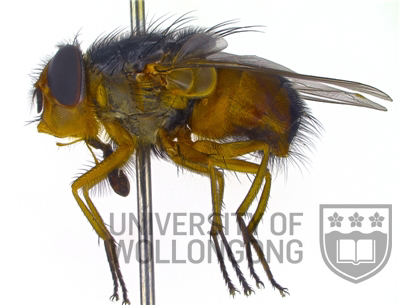Taxonomy
Family: Calliphoridae
Subfamily: Calliphorinae
Genus: Calliphora Robineau-Desvoidy 1830
Subgenus: Paracalliphora Townsend 1916
Species: dubia (Macquart 1855)
The third-instar larva was described by Wallman (2001).
Biology
Calliphora dubia is attracted to carrion early in decomposition and is a primary sheep fly (Norris 1959). It is the western analogue of its eastern sister species, Calliphora augur. Calliphora dubia is ovoviviparous, laying 30-80 larvae (Cook and Dadour 2011). Study of its development is much more limited than that of C. augur (Dadour et al. 2001).
Calliphora dubia can be distinguished from C. augur by the rich purple to blue abdominal sheen and the vivid white dust on the fifth tergite. Male C. dubia can be readily distinguished by the minimum frons width being greater than twice the width of the anterior ocellus, whereas in male C. augur the minimum frons width is less than twice the width of the anterior ocellus (see picture). To determine the gender of your fly click here.
Distribution
Calliphora dubia is found throughout south-western and central-southern Australia. It occurs sympatrically with Calliphora augur in eastern South Australia, Kangaroo Island and western New South Wales and Victoria (Wallman and Adams 1997). It has been recorded in all states and territories, apart from Tasmania, although in the eastern states it is relatively uncommon (Johnson 2007).
Relevant Literature
Cook, D.F. and Dadour, I.R.
(2011) Larviposition in the ovoviviparous blowfly
Calliphora dubia. Medical and Veterinary Entomology
25, 53-57.
Dadour, I.R., Cook,
D.F., Fissioloi, J.N. and Bailey, W.J. (2001) Forensic
entomology: application, education and research in Western
Australia. Forensic
Science International
120,
48-52.
Johnson, A.P. (2007) Climatic and biotic influences on the
distributions of Calliphora
augur and Calliphora dubia (Diptera:
Calliphoridae). B.Sc. Honours, University of
Wollongong.
Morris, B. (1993) Physiology and taxonomy of blowflies. M.Ag.Sc., The University of Adelaide.
Norris, K.R. (1959) The ecology of
sheep blowflies in Australia. In: Keast,
A., Crocker, R.L. and Christian, C.S. (eds.) Biogeography and
Ecology in Australia. The Hague: D. W. Junk.
Wallman, J.F.
(2001) Third-instar larvae of common carrion-breeding
blowflies of the genus Calliphora (Diptera: Calliphoridae) in
South Australia. Invertebrate
Taxonomy 15, 37-51.
Wallman, J.F. and Adams, M. (1997) Molecular
systematics of Australian carrion-breeding
blowflies of the genus Calliphora (Diptera:
Calliphoridae). Australian
Journal of Zoology
45,
337-356.
Watts, J.E., Muller, M.J., Dyce, A.L. and Norris, K.R. (1976) The species of flies reared from struck sheep in south-eastern Australia. Australian Veterinary Journal 52, 488-489.



